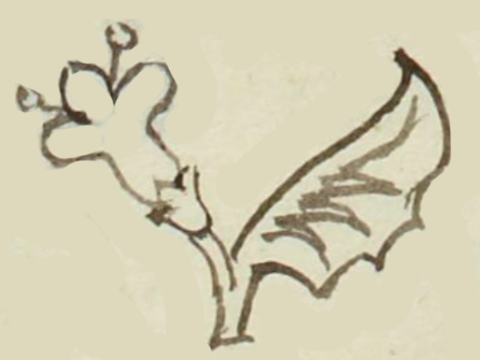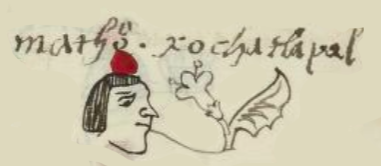Xochitlapal (MH779r)
This black-line drawing of the compound glyph for the personal name Xochitlapal (perhaps “Flower’s Leaf” or “Red Flower”) is attested here as a man’s name. The glyph shows a flower with an especially large leaf (atlapalli) on one side (-tlapal).
Stephanie Wood
No color is used in the creation of this glyph, so one cannot know with certainly if red (tlapalli) is intended. If so, then this glyph is partly phonetic, with the leaf/side indicating the color red. Tlapalaztatl and Tlapalhuauh (below) are examples of glyphs that include the element -tlapal to refer to the color red, but they are colored red in those parts, which helps with the interpretation. Tlapalihuitl may refer to a red feather, but it is only shown in a black-line drawing. This digital collection does include a personal name glossed Xochiatlapal, which features a flower and a leaf, and more clearly seems to refer to the leaf, considering the “a” in the middle of the name.
Stephanie Wood
matheo xochitlapal
Mateo Xochitlapal
Stephanie Wood
1560
Jeff Haskett-Wood
flores, hojas, nombres de colores, nombres de hombres

xoch(itl), flower, https://nahuatl.wired-humanities.org/content/xochitl
-tlapal, on a side, https://nahuatl.wired-humanities.org/content/tlapal
tlapal(li), paint, dye, color, red, https://nahuatl.wired-humanities.org/content/tlapalli
atlapal(li), a leaf or a bird’s wing, https://nahuatl.wired-humanities.org/content/atlapalli
Matrícula de Huexotzinco, folio 779r, World Digital Library, https://www.loc.gov/resource/gdcwdl.wdl_15282/?sp=632&st=image.
This manuscript is hosted by the Library of Congress and the World Digital Library; used here with the Creative Commons, “Attribution-NonCommercial-ShareAlike 3.0 License” (CC-BY-NC-SAq 3.0).





